Bubbles, DNA, Quartets. An inspiring afternoon and evening, with Charlotte Jarvis, Mihailo Trandafilovski, Morgan Goff, Neil Heyde, Dr Nick Goldman. Music of the Spheres at Dilston Grove. Thanks to Marius Skaerved for the Photos.
LINK to article in the Daily Beast
Peter Sheppard Skaerved-Bubble Sequence 2015 World Premiere
Mihailo Trandafilovski-Fibers AND Coils 2015 World Premiere
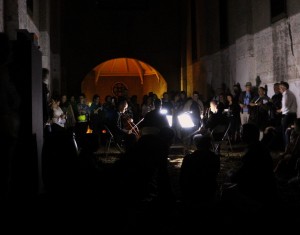
There is no ‘standard venue’. There is no ‘normal audience’. There is real enthusiasm for new music, for ideas, and for the place that art and science can meet
Kreutzer Quartet (peter sheppard skaerved, mihailo tranafilovski, morgan goff, neil heyde)
CGP London, Dilston Grove
Recorded and Engineered by Graham C Williams
Friday 12th June 2015
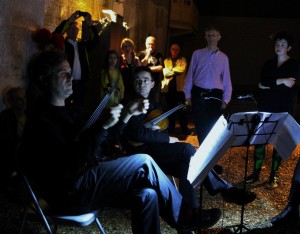
Peter Sheppard Skaerved, Mihailo Trandafilovski, mathematician Dr Nick Goldman, artist Charlotte Jarvis, in post performance Q&A
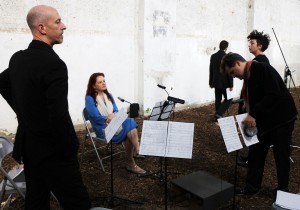
Preparation. Neil Heyde, writer Malene Skaerved, artist Charlotte Jarvis, and Peter Sheppard Skaerved
Responses to questions in online interview for the ‘Daily Beast’ 15 6 15
What appeals to you about this prospect?
Art and Science were never considered as separate entities in the past. Einstein was inspired by Bach, Milton by Galileo, Coleridge by Humphrey Davy. This project unashamedly says; these things areIb not separate, the imagination does not recognise such a separation. I wanted, I want to be part of that.
How was the composition of the piece affected by the knowledge of how it would be presented?
That’s a very good question. There were three pieces, of course-the one to be encoded into the DNA, and that was the ‘purest’, just improvised in response to the ideas and the atmosphere of the server room. The two ‘composed’ quartets certainly stretch between the ideas and the venue-which inspired the last stretch of composition, and the idea of people thronging into the amazing space at Dilston Grove, surrounded, quite literally, by the ideas and the actuality of the the DNA. Mihailo’s piece was, at one level (and I simplify) about an kind of elemental confluence of sound and idea, ringing with harmony-natural and invented, and mine was about a kind of scattering, like the counterpoints of bubbles, DNA, and thoughts in the space.
How did the quartet think conceptually about this project?
Well two of us thought as composers, and the quartet worked as improvisers responding to the idea of the project, to the technology, to the environments we experienced. The improvisation which we recorded became the basis for the two new pieces ‘Bubble Sequence’ (by me, Peter Sheppard Skaerved), and Mihailo Trandafilovski’s ‘Fibers AND Coils’.
How did you meet Dr Goldman and Ms Jarvis?
How did you gain access to the server room and why was that the performance space of choice?
The work we did in the server room was improvisation responding to the extraordinary (and quite dangerous) noise levels, and the atmosphere of the room and its environment. I particularly enjoyed the sense of frenetic technological activity-the humming, thrumming, high harmonics, enormous overtones, heat, together with the light effects-the looming server banks, with whirling, winking lights, wires coiling everywhere; this was in concert with the conversations we were building with Nick and Charlotte, their ideas, and the access to their materials. I have a some pages of Nick’s notes on my desk, which of course I don’t understand-but I can see patterns, and have the sense of awe at the intellect, the power of the ideas.
How will the second movement of the piece be heard? How is DNA music “played back,” or do we simply “carry it” with us?
The second movement can not be heard without a ‘reader’ to decode this piece. It drifts into the space, in the bubbles, and is carried out by the audience. Inevitably, quite soon, the technology to ‘read’ the information encoded into the DNA will be commonplace. But for now, like the Bach and Robert Johnson sent out with Voyager 1 in the early 70s, it is drifting around in the bubbles at Dilston Grove, and on the clothes of the people who come to the exhibition and the opening.
What else should I know about the project?
That it was performed on ancient instruments-violins from the early 17th century, a viola from the 18th, a cello from the early 19th. I love the idea that something so much of our time, is so well served by the instrumennts of the past!
How was the first performance received?
The evening was inspiring for us; I would hesitate to call it a concert-the whole experience was like an ideal ‘salon’, which built towards extraordinarily concentrated and relaxed (this is not a contradiction) listening, and then discussion afterwards. This was a challenging event, with very new music, very new art, cutting edge science, which nonetheless had a playful feeling, appealed to young children, who were excited about the music in the DNA in the bubbles, on their skin, their clothes. We are still on a ‘high’ from the concentration and enthusiasm of the audience, and the experience of building this project with such fantastic collaborators as Charlotte Jarvis and Dr Nick Goldman.

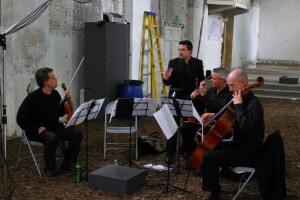

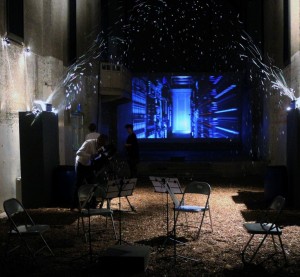
Posted on June 12th, 2015 by Peter Sheppard Skaerved